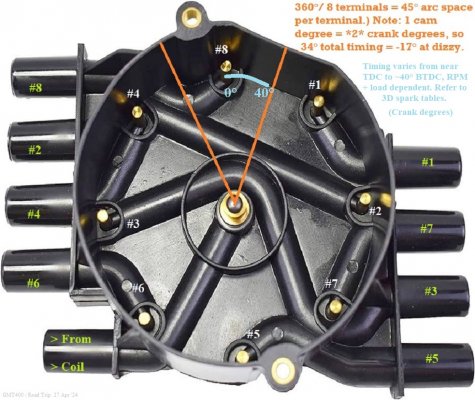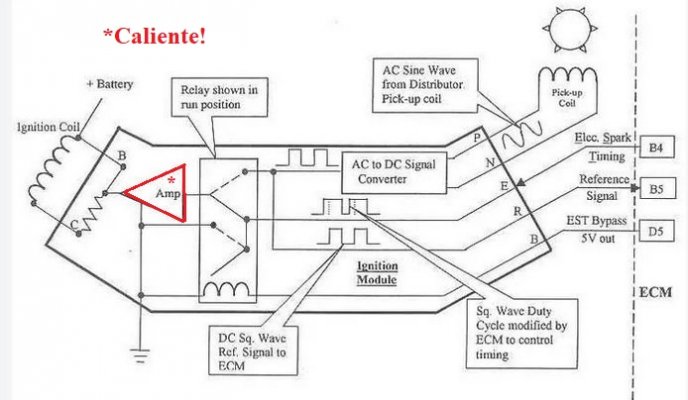From the shop to my moms house was 15 miles. During that whole drive I didn't have a single issue. It didn't overheat, it didn't stall or stutter, absolutely nothing wrong with the truck during that time. Which is even more confusing.
1952Chevy,
Sorry to hear that your traveling companion has taken ill that far away from home. I think we were correct in
focusing on that wild 80 degree swing between the CMP & CKP sensors, so I'm disappointed that the sensors
themselves didn't resolve the issue. Others in here have already shared valid troubleshooting suggestions based
upon wiring harness or thermal instability, so I'd like to work those into the following. (!)
So, in order to maximize our chances of you getting your machine back to Idaho under it's own power without
hurting it further, I'd like to go over this crazy-reporting sync circuit in question. (With the idea of if we were to {temporarily}
remove/disconnect this CMP/CKP monitoriing circuit from the equation, and in response the engine/VCM combo settles down?
Sure, the SES light is on...
but at the same time the truck drives back to Idaho the same way it just did to mom's house?)
...but I am ahead of myself. Let's discuss the circuit in question, what it gives us, and it is absolutely necessary in order to
'one time flight' the vehicle back home? NOTE: The following may be a bit lengthy, but my goal is to help
you figure out if it's possible to get your GMT400 home under it's own power instead a incurring the cost of
a large U-Haul or paid pro to drag it back to Idaho. :-(
****
First of all, when you are reading the following, I want you to keep in the back of your mind that the
'95 TBI 454 could
not tell you anything about a misfire, whether random across all cylinders or only
in one hole. Mechanics troubleshot misfires the way they always did. And the fuel was injected
like an electronic 2-bbl carb. Each of the 2 injectors fed 4 cylinders each via a wet intake manifold that
split the fuel delivery into alternating cylinders in the firing order.
1996 was a big year for engine management due to the need for all the auto manufactures to meet the
newly mandated 2nd generation On Board Diagnostics based upon SAE technical recommendations.
(OBD-II -- See attached.) And of course the ever-tightening emissions and CAFE goals too.
So in response GM upgraded the fuel delivery from 2 shared fuel injectors alternating feeding the engine to
8 individual fuel injectors, organized so that they could support the goal of metering fuel into the engine by
following the firing order, maximizing the accuracy of the fuel delivery. For the computer to do this, it needed
to know where the engine crankshaft was rotationally as well as which cylinder was next in line? This is
where the CKP & CMP come into play.
With this circuit GM could solve the SFI goal *and* also meet the part of the OBD-II spec having to do with
EFI misfire diagnosis. Q: But if we can't have everything, then what does the engine actually
NEED in order to operate?
A: If you answered the CKP signal, then you are correct. It is used to allow the delivery of fuel (individual injector
pulses as well as powering the fuel pump relay beyond the first 2 seconds) as well as enabling the ignition system
spark generation. Pretty important signal. Intermittently losing this signal will cause the computer to freeze/restart, causing
obvious driveability issues.
But what about the CMP signal? Well, with a CMP signal in sync with the CKP signal, we get the fueling optimization
afforded by the SFI feature. (Sequential Fuel Injection) Guess what? Instead of having a customer get stranded by a failure
in the CMP circuit, *if* the CMP signal gets lost, then as a backup strategy the Fuel Delivery defaults to a 'batch mode'
firing of the injectors. (Similar to the TBI, where at cranking speeds you can actually watch the 2 TBI injectors take turns
firing. (!) My understanding is that in batch mode 4 injectors fire, alternating with the other 4 firing...but don't
quote me on this. But from all reports batch-fire runs just as good as the '95 TBI setup, so this backup strategy is
very subtle to detect in normal driving.
Given the above, assuming that there's some sort of anomaly in the engine wiring harness feeding the CMP circuit
(think +5v reference getting shorted out due to engine movement on the mounts) and the VCM is a victim of this,
then what if we were to pull the connector to the CMP sensor? Sure, the computer would lose track of the cylinder
to cylinder fueling info, but this should just kick it into batch-fire mode...and as a long as the engine runs steady,
you can drive it back to Idaho. And my understanding (from other people driving long periods of time with a
steady P1345 code) ...these engines can run just fine that way. Maybe batch-mode is only 99% of perfection instead of
99.9% from SFI, but who cares? We're thinking 1-time flight back to home base, where you can fillet the engine
bay wiring harness at your leisure?
****
Of course, if you disconnect the CMP signal and the truck starts running good enough to drive home, great!
But if it doesn't, then what are other possible failure scenarios that you could explore a bit? Here are some
possibilities:
* VCM is
victim of flaky input from CMP sensor and/or associated wiring. (+/- 40° leading/lagging CMP signal)
* VCM is
victim of flaky input power/ground connection throwing off critical sensor input(s) or inability to 'fire'
injectors because it can't give them a good enough ground to enable them. (!)
* VCM is
perpetrator of flaky operation despite receiving solid signals from both CKP & CMP sensors. (!)
* VCM is
perpetrator of flaky operation due to thermal instability. Hints: Problem never occurs stone cold,
only after nn minutes of operation. Especially if the VCM can be made to work for longer periods of time
if ice-water soaked t-shirt draped over VCM housing extends operation from nn minutes to 2x or 3x the
normal failure interval. (No kidding, I once owned an old Civic with a thermal-sensitive ignitor in the dizzy,
and if I had a hot-start failure I had a gallon jug of water behind the driver's seat, and pouring a quart or
2 of water onto the (horizontal off of the end of the OHC) aluminum dizzy housing would always get it to
fire. Got some strange looks in the supermarket parking lot...but during the troubleshooting phase this
was the secret sauce of success.)
****
I've included a couple of ignition-related pics just to help give you a better feel for this flaky failure
vs the setup that the computer is trying to make sense of. For example, in the 2nd attachment we can
see that each spark plug wire terminal has 45 total (distributor) degrees of rotor rotation dedicated to it.
(+/- 22.5 cam degrees)
But since everything is referenced off of the crankshaft position, this same exact space would be referred to by
the VCM as 90° worth of
crank degrees. (Due to the 2:1 relation set up by the crank vs cam gear diameters.)
Ergo, when you observed the ~45 degree reading when you disconnected the CMP sensor,
this makes sense to me. Anything beyond +/- 45° (crank) is an illegal condition, and would all but
guarantee the physical sending of a 'spark to the wrong-cylinder' & resulting misfire.
And in the 3rd attachment is a simplified block diagram showing the conversion of the sine wave off of
the CMP sensor into a square wave. Now we know that the Reference signal actually comes from the
CKP sensor on the Vortec motors, so disregard the reference to the 'Reference' signal in this older
block diagram. Instead, imagine if there are voltage variations that are affecting the sine wave > square wave
conversion. This is just a swag, but unexpected amplitude changes of the sine wave (or malfunction of the
signal converter) could be giving us a wack-a-doodle CMP signal. (Doesn't *have* to be a wiring harness issue.)
But by the same token, your distributor is new, the CMP sensor is newer yet, while the wiring harness is much older?
****
All of the above is just food for thought. I looked at your fuel trims and other stuff, and all looked to be
rational. The only super flaky thing so far is the CMP stuff, and maybe the VCM gets thrown for a loop by
a gyrating CMP signal? I've never heard of a +40/-40 swing in this signal before?
It will be interesting to see if disconnecting the CMP sensor, forcing the 'Cam Ret' to a stuck-at 45° signal
allows the VCM to regain it's composure and batch-fire your truck all the way home. Or does the problem
return even with this suspect signal disconnected, and it turns out to be a thermal failure?
Anyway, this gives you a couple of things to try. Sometimes stripping a system down to the bare essentials
allows us to avoid the long-distance tow hook.
Best of luck getting a handle on this tough intermittent. BTW, good updates with what's transpired.
Looking forward to your next status report.




